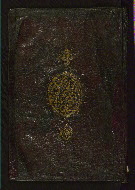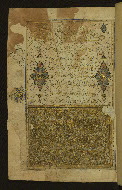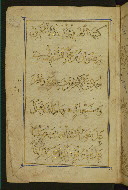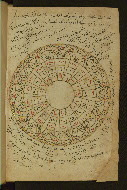Home > Digitized Walters Manuscripts
This document is a tranformation of a TEI P5 XML manuscript description incorporating images. If you have trouble reading special or non-Latin characters on this page, please make sure you have appropriate Unicode fonts installed and an up-to-date web browser.
Walters Ms. W.581, Amplified poem in honor of the Prophet Muhammad
Browse images (Browse images in a new window) | TEI in XML format
W.581
Amplified poem in honor of the Prophet Muhammad
Vernacular: تخميس البردة
As-written name: Nāṣir al-Dīn Muḥammad al-Fayyūmī
Name, in vernacular: ناصر الدين محمد الفيومي
Authority name: al-Būṣīrī (d. 694 AH / 1294 CE)
As-written name: Sharaf al-Dīn Muḥammad ibn Saʿīd al-Būṣīrī
Name, in vernacular: شرف الدين محمد بن سعيد البوصيري
This manuscript is a copy of the poem in honor of the Prophet Muhammad known as Qaṣīdat al-burdah (The poem of the mantle) by Sharaf al-Dīn Muḥammad al-Būṣīrī (d. 694 AH / 1294 CE), with an amplification (takhmīs) by Naṣīr al-Dīn Muḥammad al-Fayyūmī. The amplification and the text of the Qaṣīdat al-burdah were written in naskh and thuluth scripts respectively by Riḍwān ibn Muḥammad al-Tabīzī in 767 AH / 1366 CE, probably for the Mawlawī (Mevlevi) Library in Konya, Turkey.
Jumādá II 767 AH / 1366 CE
Turkey
As-written name: Riḍwān ibn Muḥammad al-Tabīzī
Name, in vernacular: رضوان بن محمد التبريزي
Book
Literary -- Poetry
The primary language in this manuscript is Arabic.
- Transliteration: katabahā al-faqīru ilá Allāhi al-ghanī /1/ Riḍwānu ibn Muḥammadin al-Tabrīzīyu fī /2/ Jumādá al-ākhir min sanati sabʿin wa-sittīna /3/ wa-sabʿimiʾatin ḥāmidan li-Llāh taʿālá /4/ ʿalá niʿamih al-sābighah wa-muṣalliyan /5/ ʿalá nabīyih Muḥammadin wa-ālihi wa-ṣaḥbihi musalliman /6/
- Comment: Gives the name of the scribe and the date of copying
Paper
Laid paper with chain lines grouped in twos
Foliation: i+27+i
Catchwords: Outside the frame by a later hand
18.0 cm wide by 27.0 cm high
16.0 cm wide by 23.0 cm high
- Columns: 1
- Ruled lines: 12
- Framing lines in blue, gold, and black
- Title: Takhmīs al-burdah
- Authors: Nāṣir al-Dīn Muḥammad al-Fayyūmī; al-Būṣīrī (d. 694 AH / 1294 CE)
- Scribe: Riḍwān ibn Muḥammad al-Tabīzī
- Incipit: قال الشيخ الامام ... سبب انشائ هذه القصيدة ...(takhmīs) ما بال قلبك لا ينفك ذا ألم...
- Hand note: Amplification text written in naskh script; text of poem written in thuluth script; colophon written in gold tawqī script
- Decoration note: Illuminated title page with patronage statement (fol. 1a); poetical composition in the form of a circular diagram in gold with black and red inscriptions (fol. 27b); framing lines in blue, gold, and black
Upper board outside:

- Title: Bookbinding
- Form: Bookbinding
- Label: This brownish red leather Ottoman binding probably dates to the 10th century AH / 16th CE. The central lobed oval medallion has a stamped cloud and floral motif design with a gilt ground.
fol. 1a:

- Title: Illuminated title page with authors' names and patronage statement
- Form: Title page
- Label: This illuminated title page gives the title of the work, as well as the authors’ names. There is also a statement referring to the patronage of the manuscript, indicating that it was made for the Mawlawi (Mevlevi) Library (bi-rasm al-Khizānah al-Karīmah al-‘Ālīyah al-Mawlawīyah).
fol. 27a:

- Title: Colophon in gold tawqī‘ script
- Form: Colophon
- Label: While the texts of this manuscript are written in thuluth and naskh scripts, the scribe used tawqī‘ script to write the colophon, as was common in the Islamic manuscript tradition.
- Comment:
The colophon is written in gold tawqī‘ script. The scribe signs himself as Riḍwān ibn Muḥammad al-Tabīzī and indicates that the manuscript was copied in 767 AH / 1366 CE.
fol. 27b:

- Title: Poetical composition in the form of a circular diagram
- Form: Circular diagram
- Label: The manuscript's final page contains a poetical composition in the form of a circular diagram in gold with black and red inscriptions. A later note in Ottoman Turkish concerning some points of jurisprudence (fiqh) surrounds the diagram.
The binding is not original.
Probably dates to the tenth century AH / sixteenth CE; brownish-red leather (no flap); central lobed oval and pendants
Made for the Mawlawi (Mevlevi) Library (bi-rasm al-Khizānah al-Karīmah al-ʿĀlīyah al-Mawlawīyah…) probably in Konya, Turkey (fol. 1a)
Walters Art Museum, 1931, by Henry Walters bequest
Brockelmann, Carl. Geschichte der arabische Litteratur (New York; Köln: E.J. Brill, 1996), 1:312; S1:469.
Principal cataloger: Gacek, Adam
Catalogers: Landau, Amy; Smith, Sita
Editor: Bockrath, Diane
Conservators: Jewell, Stephanie; Quandt, Abigail
Contributors: Barrera, Christina; Emery, Doug; Herbert, Lynley; Noel, William; Simpson, Shreve; Tabritha, Ariel; Toth, Michael B.; Valle, Chiara
The Walters Art Museum
Licensed for use under Creative Commons Attribution-NonCommercial-ShareAlike 3.0 Unported Access Rights, http://creativecommons.org/licenses/by-nc-sa/3.0/legalcode. It is requested that copies of any published articles based on the information in this data set be sent to the curator of manuscripts, The Walters Art Museum, 600 North Charles Street, Baltimore MD 21201.